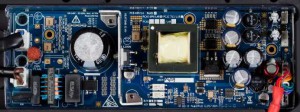The Apogee MiniDAC is a pro-audio two channel digital analog converter. It received very good reviews when it was first introduced. The price dropped after a few years, making it good value for money. I managed to get hold of one and of the firewire interface board a little later. The firewire board is a BridgeCo design, running an ARM processor. The firewire interface deploys a smart architecture where multiple firewire units can be used together with one unit delivering the master clock to all other units. Due to the firewire architecture the computer’s driver can also be the master. The Apogee driver on OSX by default uses the DAC’s internal clock as external clock input. In this setup the computer audio driver is slaved to the DAC.
The MiniDAC has a balanced output running at pro-audio level of +24 dbU. I wanted to find out if it would bring more to use this balanced signal, or to ungracefully “unbalance” it by using the hot signal and ground the return (this is what a XLR to RCA adapter does). Looking at the print layout and number of op-amps used, I concluded that the MiniDAC already actively unbalanced the output of the AD1955 DAC chip, then does some switching (jumpers) and audio level adjustments (the blue trim-pots), and then (re)creates a balanced audio signal (the op-amps in the middle, left of the trim-pots) and driving the XLR outputs (on the far left). After all, you cannot adjust the audio level of a real balanced stereo signal with two trim-pots…

This would imply that a XLR to RCA adapter would not impact audio quality. The XLR output level can be reduced to consumer audio levels using the internal trim-pots. I suggest using Neutrik XLR to RCA adapters; the cheap ones I first tried, well .. are cheap.
The supplied power supply of the MiniDAC is a simple switched type. Internally the Apogee “processes” the voltage from the power supply and converts it to the different voltages internally needed. This DC-DC conversion uses a high frequency switcher and small transformers. So in principle it does not matter what type of external power supply is used since the internal DC-DC conversion completely isolates the external power supply from the internal electronics. However many people replace the external PS and mention noticeable improvements.
I think that they are right, but not because the voltage “quality” has improved. I think they are right because any switched mode PS produces a certain amount of HF radiation and often has considerable leakage from primary to secondary. The wires connecting the PS to the MiniDAC act as an antenna, making things worse. You can test this yourself: measure the voltage between the MiniDAC’s enclosure and ground with a digital voltmeter. Then replace the power supply with a linear transformer based one and measure again.
Switched mode PS’s aren’t bad or evil; take a look inside one of the best audio streamers, the Linn Klimax (15000 Euro price range) and you will not see conventional 50Hz based mains transformers:

It all boils down to proper engineering: it’s easier to engineer a good linear (transformer based) power supply than a good switched mode power supply. And it’s very easy to engineer a bad switched mode PS…
